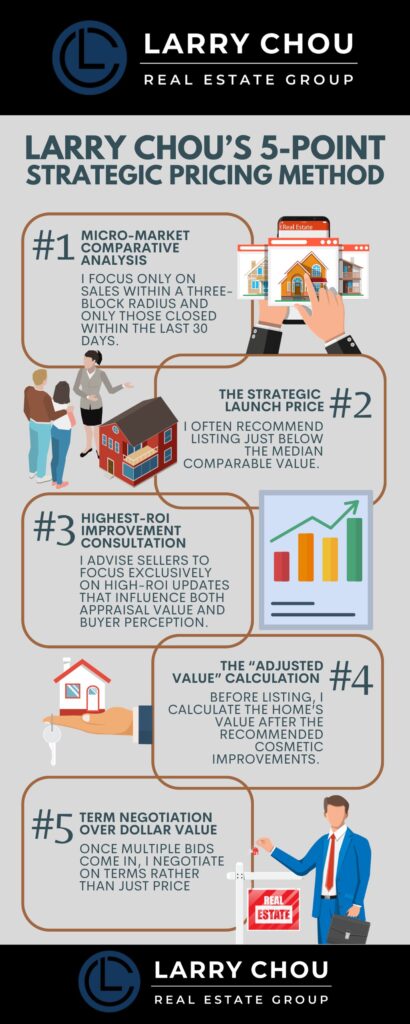In the unique, hyper-competitive Silicon Valley real estate environment, pricing your home is the single most important decision you will make—it determines if you sell high or if you sit and slash the price later.
In a market as sharp and fast-moving as Campbell, California, small missteps can cost homeowners tens of thousands of dollars. Buyers here are savvy, analytical, and quick to judge.
They compare your home’s price per square foot with a dozen others before they ever set foot through your door. That’s why pricing isn’t guesswork—it’s a science.
Hi! I’m Larry Chou, Campbell’s dedicated Pricing Specialist. I’ve built my reputation on precision and strategy. I don’t just look at comps; I analyze market behavior, data, and timing to craft a pricing plan that delivers the highest possible return for my clients.
My clients aren’t just selling homes—they’re strategically positioning valuable assets in one of the most data-driven real estate markets in the country.
In this guide, I’m sharing my multi-faceted strategy on home pricing Campbell, CA, outlining the steps every seller should take to set the perfect list price and attract multiple, competitive offers.

The Foundation: Why Price Is King in Campbell
The Silicon Valley Buyer
Homebuyers in Campbell operate differently. They’re tech professionals, engineers, and investors—people who live and breathe analytics.
They’re comparing your home to properties in Cupertino, Los Gatos, and San Jose’s Willow Glen, weighing proximity to work, schools, and amenities.
Campbell house pricing is critical. An incorrectly priced home raises a red flag. If it’s priced too high, it looks suspicious—why pay more when a similar property nearby sold for less last week?
If it’s too low without a reason, buyers wonder if something’s wrong with the house or neighborhood. In a data-driven market, credibility starts with price.
The Cost of Stagnation
As I often tell my clients, “A home that sits for more than 15 days on the market will usually sell for less than its true value. Buyers start to assume something is wrong, even when it’s not.”
Days on Market (DOM) is the pulse of Silicon Valley real estate. The first two weekends determine your fate. If momentum dies early, your listing loses leverage—and once that happens, price reductions rarely recover full value.
The longer the property lingers, the more aggressive buyers become, often negotiating tens of thousands off your asking price.
The Goal: Competitive Pressure
The ideal price doesn’t just aim to sell—it aims to spark competition. The goal is to engineer a bidding environment, not chase one.
Strategic Campbell house prices attract multiple offers quickly, which naturally pushes the final sale price above the list price. The best pricing isn’t about guessing what your home is worth—it’s about making the market prove it.

Larry Chou’s 5-Point Strategic Pricing Method
1. Micro-Market Comparative Analysis (The Gold Standard)
Most agents rely on general Market Comparative Analysis reports that cover zip codes or wide areas. My approach goes much deeper.
Strategy: I focus only on sales within a three-block radius and only those closed within the last 30 days.
This hyper-local analysis captures micro-trends that broader data misses—like sudden shifts due to nearby new listings, recent school boundary changes, or even a surge of tech hires in the area.
Action: This granular approach identifies your home’s true immediate value—not last quarter’s numbers, but what buyers are willing to pay right now.
2. The Strategic Launch Price (The Art of the Underbid)
It sounds counterintuitive, but in Silicon Valley, slightly underpricing can be a power move.
Strategy: I often recommend listing just below the median comparable value. Why? Because the lower list price acts like a magnet. It creates a buying frenzy in the first weekend, drawing serious buyers and generating emotional urgency.
Action: The influx of showings and offers creates a competitive environment that drives the price beyond the asking point. The end result? You sell faster, cleaner, and often for more than if you’d started higher.
3. Highest-ROI Improvement Consultation
Renovating before selling can be risky—but not if you know where to spend.
Strategy: I advise sellers to focus exclusively on high-ROI updates that influence both appraisal value and buyer perception.
Instead of tearing down walls or adding expensive rooms, I look for simple, visible improvements that make the home feel fresh and cared-for.
Action: Think fresh paint, decluttering, modern light fixtures, new hardware, and strategic staging. These updates are affordable but dramatically improve first impressions—an essential factor in justifying a top-tier offer.

4. The “Ad justed Value” Calculation (For Condition)
Every home has nuances—wear, maintenance needs, or minor cosmetic issues. My method accounts for these from the start.
Strategy: Before listing, I calculate the home’s value after the recommended cosmetic improvements. This anticipates the buyer’s mental math and preempts discount requests.
Action: By pricing with deferred maintenance already considered, you minimize negotiation points later. Buyers feel they’re getting a fair deal, and you maintain control of the pricing narrative.
5. Term Negotiation Over Dollar Value
Winning in Campbell isn’t always about the highest number—it’s about the strongest terms.
Strategy: Once multiple bids come in, I negotiate on terms rather than just price—focusing on offers with fewer contingencies, higher earnest deposits, or all-cash buyers.
Action: This approach minimizes risk and maximizes net profit. For sellers, it means fewer last-minute fall-throughs, faster closings, and a smoother path to escrow. In a fast-moving market, reliability is often worth more than a few extra dollars.

Conclusion
My proven system combines three essential pillars—Micro-Market Analysis, Strategic Launch Pricing, and ARV (After Repair Value) Focus—to produce exceptional results in Campbell’s competitive housing scene.
In a city where homes often sell in days and market perception shifts overnight, success depends on precision. The right pricing strategy doesn’t just set your listing apart—it creates demand. And when demand drives your sale, you don’t just sell—you win.
If you’re preparing to sell your home in Campbell, don’t leave your biggest financial decision to chance.
Give me a call today at (408) 759-1201 for a confidential pricing strategy session and discover how a data-backed approach can unlock your home’s full value.
Frequently Asked Questions
What does a Pricing Specialist do differently from a regular Realtor?
A Pricing Specialist focuses solely on data analytics, market timing, and positioning to optimize the sale price. Regular agents may handle listings and showings broadly, but a specialist fine-tunes price strategy to outperform the market average.
How does pricing affect the “Days on Market” (DOM)?
Homes priced correctly sell faster and closer to (or above) list price. Overpriced homes linger, forcing later reductions that often lead to lower overall returns.
What are the most common pricing mistakes sellers make in Campbell?
Overpricing based on emotion or Zillow estimates, underestimating the impact of condition, and ignoring micro-market data are the biggest pitfalls.
Is it better to overprice or underprice my home in Silicon Valley?
Underpricing strategically—by a small margin—often results in multiple offers and higher final prices. Overpricing typically reduces buyer interest and increases time on market.
What home improvements offer the best return on investment (ROI)?
Cosmetic upgrades like paint, lighting, landscaping, and staging consistently deliver the best ROI. Major structural changes rarely recoup their cost.
Who is Larry Chou, and what is his experience in Campbell?
I am a seasoned real estate professional and Pricing Specialist serving Campbell and the greater Silicon Valley area. I’m known for turning complex market data into actionable, profitable pricing strategies for homeowners.
What are the risks of using a price to “test the market”?
Testing the market with an inflated price backfires quickly—buyers notice, engagement drops, and price cuts later signal desperation. A strategic price from the start ensures momentum and confidence from day one.



